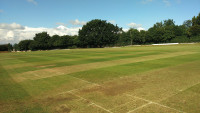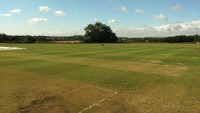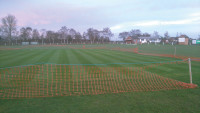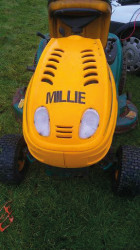Jack of two trades!

It's difficult to precisely pin down the dawn of North Warwickshire Cricket Club (NWCC); certainly it was running in 1952 when the owners of the land on which the North Warwick Colliery then stood purchased nearby land on Hermitage Hill so that the workforce could enjoy recreational facilities, which not only included cricket, but also football, tennis, bowls and even tug of war. By 1954, the cricket club was firmly established when the ground was gifted both to them and the North Warwick Colliery Sports and Social Club.
Regular friendly games took place until the formation of the the then James Travel League, one of the many leagues that eventually made up the Midland Combined Counties League in the early nineties. Further leagues were formed for Sunday and mid-week cricket, all of which North Warwickshire embraced, as well as hosting its own knock out competition each June, along with other local clubs - making the long summer evenings a busy time.
A junior section was also formed in 1990 and, within a couple of years, had become one of the Midland's leading teams with many victories in leagues and knock out competitions, including reaching the finals in the Lord's Taverner's U16 tournament and the national U13s final at Sherborne in Dorset.

Today, the club plays in the Warwickshire Cricket League on Saturdays and in the Lichfield & District Sunday League on Sundays. A resurgence of interest in mid-week cricket sees the club hoping to rejoin the Thursday Nuneaton & District League in 2017, whilst the junior section now takes part in Warwickshire competitions from under 9s to under 13s.
The club's groundsman is Jack Chapman, who has been doing the job for just over a year, but has played for the club since the age of fourteen.
"Since a young teenager, I had picked up pocket money mowing lawns in and around my village of Kingsbury, near Tamworth. I had a push cylinder mower for the first year - lightweight, perfect to roll around the village and highly underrated! Alongside my GCSEs and A-Levels, I'd never really given it a thought that this would form the basis of a business. Alongside my studies, and through plenty of positive word of mouth referrals, I was looking after the gardens of around twenty-five homes just four years later."
"Despite going to Loughborough University to study Sport Management, the business continued to grow, so I purchased a Vauxhall Combo van and got it signwritten. In the meantime, I was getting the odd hint dropped at NWCC regarding our deteriorating playing surface - asking what I knew and what could be done which, then, was very little!"
"The Pitchcare spring and summer one day course came about when I offered my services to the NWCC committee. I found the course presented by Bob Stretton motivating and enjoyable. He has been a great help since with any queries as well."

"Playing for the cricket club in my teenage years, I'd always appreciated the work of our old groundsman, Ken Kniveton. He'd often been able to prepare some belters at our place, and I was fortunate enough to be playing junior cricket on some good grass wickets. As a teen playing 2nd XI cricket, I'd often get back to the club to find our first XI had posted a big score and us struggling to get past numbers 7 and 8. Only now do I realise the work that had to go into those pitches!"
"The outfield was in a better condition back then as Ken would mow a couple of times a week. The triple mower he used I understand is beyond repair and has never been out of the container in my time. The colliery welfare brings in a contractor now."
Jack sets his own budget and says that the business background of his degree allows him to work closely with the treasurer to make the club's cash go as far as it can. Resources are extremely tight with rent payments to the welfare and no major sponsorship. "The playing surface is our biggest expense as a club, so I feel a responsibility to use any money wisely, and I feel the committee trust me to do that. The way it should be." he states.

"A couple of members tend to chip in on an ad-hoc basis around their work. The club has certainly benefitted enormously this past winter from Richard Stonehouse being able to commit a great deal of time. He's someone I can call on whenever I need another pair of hands. He's been around the club for years and is a vital cog in our make-up; a real utility guy, whether helping me, junior coaching or assisting the committee."
Agronomic help comes from Joe Vary at Pro-Organic who has assisted in setting up a fertiliser programme on, what is, a tight budget following some soil testing over the winter. "We have also brainstormed some granular products for lawn care that he has blended to my needs. I'm looking forward to giving his concoctions a go in the very near future."

"The site is on a hill and very exposed to the south-west, so high winds, with spring feeling like the depths of winter, is not uncommon. The drying process on the square can be rapid at times. I sometimes have to flash pitches only three or four days out from a fixture dependent on conditions. As soon as our pitches are dry, they take some serious soaking before any renovation can be carried out. In perfect conditions, or if I'm able to get up to the club more than normal, we can produce some really good cricket wickets that are batsman friendly, but offer pace and bounce. Having a surface with some good bounce and carry doesn't seem that common in my experience of Warwickshire league club cricket, but there's a few out there. As a 'keeper too, I'm happy to have the ball carrying through, of course."
Jack says that the club hasn't owned any roll-on covers for a number of years after the last lot were vandalised. "In recent years, we have used a flat sheet, which puts you at risk of being thrown into the air at times by the wind! A flat sheet does a reasonable job, but damp patches and spills are common, and it always seems to be on a length. Using a flat sheet, the bowlers run up at the bottom end is prone to waterlogging in any lengthy rain delay."

"During the off-season, I try to mow as frequently as is required with one of my Hayter Pro 48s at 18.5mm. As for aeration, one of our members, Mike Smith (aka 'Smudge'), can borrow a mechanical aerator from our local crown green bowls club where he assists his dad, so we get by without our own machine. It would be a big investment for the sake of one annual use in November. I sarrel roll monthly, but it is a very old tool with worn spikes."
"Trying to keep the mesh fence in reasonable shape is another regular winter task. I feel that, before I took on the square, winter maintenance was minimal. In March 2015, the square had a lot of moss in the surface, requiring fairly heavy scarifying, which was far from ideal, leading to us entering the season with the grass on the thin side - but that's not the case this season," comments Jack.
"The square is maintained at a height of 12mm from April onwards. I don't see the need to go any lower with the local conditions - it would only lead to stress placed on the sward and further requirement for watering in summer."
"I operate a twelve day pitch preparation, which I can extend by a couple of days in spring or if adverse conditions are expected. I can get by with 8-10 days in mid-summer, I've found. We have a mechanical scarifier, along with my own push rake, which I use to stand the grass up when preparing pitches. The standard match height is 4mm. I have also experimented with leaving the match pitches up at 5-6mm. The bowlers still blame me if the ball is going to the rope though!"

"On a monthly basis, I like to lightly scarify the whole surface. We don't have a verticutter, but that would be the ideal machine for the job to help the grasses stand tall with less horizontal growth - something that Bob Stretton picked up on when he called by last season."
"For 2016, I will be using Pro-Organic's Polaris slow release granular products. This includes a 15:4:8 in March, 15:0:0 in late June, and 15:0:0 at in mid/late September, with renovations. These applications at varying rates should reflect the plant's nitrogen demands perfectly for the local conditions all year around. The square suffered from red thread in the autumn, so I hope this calculated nitrogen supply will go a long way to solving this. In 2015 our feeding was far too random, making use of whatever was in the container."
"When it comes to specific tasks, I do my best to look after Chetty; he does maybe two thirds of the total rolling, freeing up a lot of my time for other key tasks. I get the impression he finds this a little tedious at times, but I am concerned that our Ransomes will take him across a football pitch and into a hedge! When it comes to setting out the boundary and those little match-day jobs, I expect the players to have that all in hand. It's nice to occasionally have a player up a little earlier just to give a quick hand, even if it's just to help mark or put things away - after all, they expect me to score runs and take catches too!"
Presentation ranks highly with Jack. "With the day job in mind, it is what people pay for Monday to Friday. Attention to detail is key. High level presentation simply shows pride in the job. I want our pitches to be a reason why people come to play and continue to play for our cricket club. With such a high usage of the site, I want people to be talking about the cricket club for the right reasons. With the high level of football, I feel, to an extent, that my business is on show too."

"Previously, scarification had involved just two passes so, considering the thatch levels, this was a couple of lighter passes and a couple of deeper passes, including shaving the square and removing a couple of tonne bags worth of arisings, cleared up with one of my Hayter rotaries.
I certainly scarified more aggressively than in previous years and hope this will pay dividends this season. Thankfully, I had plenty of help during the week from the cricket club members."
"Next, the sarrel roller makes an appearance in four directions to create as much seed to soil contact as possible. Our final slow release feed will be applied around this time (not the case in 2015) before sowing the best part of two 20kg bags of seed. Last season, I dressed at six 20kg bags per pitch. For 2017, I'm considering not shaving and scarifying wicket ends, repairing these all individually, concentrating efforts more towards the business area. With resources tight, I may look to use those six bags over an 18-20 yard area rather than a 25 yard area."
"Finally, the square needs to be fenced off to reduce the football damage. I have found that some laminated signage within the builders mesh has gone a long way to helping. I think players and coaches understand more why the fence is there, rather than seeing something they can jump over to get their ball."
"The committee understands that it's a vital part of the calendar for the club. At the end of the day, it has to be done - it's not an area for negotiation, whereas annual subs and match subs are! What I'm working with is pretty shoe-string as it is, but I'm proud of what was achieved in 2015 with the cash available to us, and anticipate further improvements in the surface this season."
As the season was about to get under way - which began with a friendly just a week after the NatWest Cricket Force day on 9th April - Jack was in confident mood. "After the football season had finished, we needed to get the protective fencing down from around the square and mow around the edge with our small ride-on mower, Millie. I gave the square a light scarify and a mow at 12mm. Other jobs included setting up screens for the season and some work on the portable batting net. The scorebox also needed a bit of TLC with a bit of a clear out and tidy up. It's quite exciting what we could achieve here with enough help."
Jack concludes by saying that he would like to undertake more training, but time and cost are the standard barriers. "Courses aren't cheap and I'm working up to ten months of the year with little time off. By completing the Pitchcare Spring and Summer course, plus continuous reading and participation on the Pitchcare forum, I feel as if I'm in a very good place as a volunteer groundsman. I've learned a great deal in the last year, regardless. I'm sure qualifications will happen - someone sell it to me!"

McDonald road roller
Atco Club 20R wicket mower
Ransomes Textron Marquis 5L
Bob Andrews Lawn Doctor
MTD Yard-Man tractor affectionatley known as "Millie"
"I haven't been involved in the purchase of any machinery for the cricket club. If it was required, then funds would dictate that it was secondhand. We have what we have at the end of the day."
"A wish list would include a verticutter, and a roller that can be ballasted. The welfare provide a tandem road roller with a drum width of 3 feet and a weight of around 1.5 tonne. Obviously, this provides inflexibility where weight is concerned. A Poweroll Club would be nice."
"A rotary mower that isn't my own would be handy too, allowing me to delegate more. I've got a couple of Hayter Pro 48s of my own that I've used through the off-season. A Hayter Harrier 56 would be ideal machine for the cricket club. I've had very few issues with Hayter machines and they give an impressive quality of cut and presentation."
